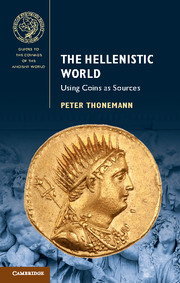9 - From Flamininus to Augustus
from Part IV - Ideology
Published online by Cambridge University Press: 05 December 2015
Summary
Ancient history from coins
Imagine for a moment that all written sources for Rome's conquest of the Hellenistic world had been lost. No Polybius, no Livy, no Cicero; no Illyrian Wars, no treaty of Apamea, no battle of Pydna. Imagine trying to reconstruct the political history of the eastern Mediterranean between, say, 229 and 30 BC from the coin evidence alone. What would Rome's arrival in the Greek East look like? Would we be able to spot the emergence of the earliest Roman provinces in the East, Macedonia from 146, Asia from 129, Syria, Cilicia and Bithynia-Pontus from 64? Whose impact would be most visible – Sulla, Pompey, Augustus?
There can be no doubt what the first coin to catch your eye would be. Around 196 BC, a very unusual issue of gold staters was struck somewhere in Greece, perhaps at Chalcis on Euboea. The ten known examples were struck from no fewer than five different obverse dies (and five reverse dies), suggesting that more than 100,000 coins may originally have been struck (Alföldi 1984; Callataÿ 2011a: 59–61). These coins carry on the obverse a portrait of a bearded male figure, without a diadem (Fig. 9.1). On the reverse, a Nike figure bearing a palm-frond (representing a military victory on land) is shown placing a wreath on the name T. Qvincti.
As the Latin legend on the reverse makes clear, these coins were struck by the great Roman general T. Quinctius Flamininus. Flamininus had defeated Philip V at the battle of Cynoscephalae in 197 BC – in effect marking the end of Antigonid Macedon as a major player in the Aegean world – and went on to proclaim the freedom of the mainland Greeks at the Isthmian games at Corinth the following year (Polybius 18.46.5). Flamininus’ declaration of Greek freedom shows how well he had grasped the kind of Philhellenic rhetoric used by Hellenistic kings in their dealings with Greek cities (Walsh 1996); it is no surprise to find him equally able to speak the charismatic ‘language’ of Hellenistic royal coinage.
Aside from the use of Latin for the legend on the reverse, Flamininus’ coinage is modelled on contemporary issues of Hellenistic kings in almost every respect. Although attempts have been made to discern a distinctively ‘Roman’ style to his coin portrait (Kousser 2010: 527–8), this is little more than wishful thinking (Touchette 1992: 244).
- Type
- Chapter
- Information
- The Hellenistic WorldUsing Coins as Sources, pp. 169 - 190Publisher: Cambridge University PressPrint publication year: 2016



